BLACK CRYSTAL OIL & GAS
OUR DEVELOPMENT PLANS
B.C. O&G engages in the acquisition, development, exploration, drilling, production and marketing of oil and natural gas leases. With new technology, natural gas is increasingly chosen as the most desirable and environmentally safe fuel of choice to produce electricity, as fuel cells, and for natural gas vehicles (NGVs). Increasingly large amounts of the processed gas are used for home cooking and industrial purposes.
Black Crystal Oil and Gas hopes to develop and enhance our assets by negotiating joint ownership agreement with already identified major oil to partially own and promptly hook-up our producing wells as they come on line, for delivery of production to designated markets as needed in newly acquired acreages and blocks in these areas . As part of our long-range operating strategy, we anticipate developing production lines for delivering our crude and refined products straight to the market.
Today, it provides new solutions which allow transforming natural gas reserves into clean-burning, safely transportable liquid fuel at a cost significantly below current state-of-the-art conversion methods.
Gas-to-Liquid conversion plants that vary in size from portable units to large scale, permanent, ultra-modern industrial facilities capable of generating electricity for a whole city, can be built to suit any desirable range of needs, regardless of the geographical location and the ecological composition of the field.
Our organization can safely harness, transport, and deliver this cleaner and desirable fuel. This is part of our commitment to reduce chemical releases and emissions, thereby conserving vital natural resources.
In an attempt to generate clean oil and gas that will engender value, integrity, and respect for our organization, the investors, customers, the community and the environment, our company will invest in pollution prevention research to reduce the cost of cleanup and compliance, support community revitalization and fast-track clean up, promote technology innovation and provide better and cheaper oil and gas sources for the public.
 B.C. O&G will:
B.C. O&G will:
- Utilize any and all available resources to execute our corporate mission and vision of excellence in drilling, exploration and production of oil and gas and/or other energy sources.
- Research areas known for high potential hydrocarbon (oil & gas) reserves with great economic exploitation pay.
- Offer and acquire mineral leases in proposed potential prospect areas.
- Develop a complete profile for all phases of our operations, from prospect generations, to review of land acquisition & management, drilling, well completion, production and marketing.
- Develop a full proposal for the project to attract investors and shareholders
- Review potential economic benefits, risks and regulatory issues that may impact prospect development
- Abide by and follow all government regulations and environmental guidelines that guide oil and gas exploration, drilling and production
- Obtain funding privately and openly in a transparent manner for the legitimate purpose of our operations.
- Develop transparent operating and management plans.
- Initiate appraisal drilling through drilling bid processes.
- Obtain, review and approve drillers’ information and background
- Operate and drill the well expeditiously.
- Identify and confirm primary and secondary production pay zones.
- Conduct and verify initial production tests
- Complete the well and start production
- Handle the day-to-day operations and management of the well, based upon developed operating plans
- Monitor production schedules etc.
- Sell the gas and oil
- Send out revenue checks monthly to stake-holders
- Handle all tax preparation pertaining to the ventures
- Provide tax info to participating stake-holders and investors, along with several reports (consisting of daily drilling reports, permits, maps, and related geology, well logs, production statistics, revenue, expense statements, survey plats, well test reports, etc., relating to the well.)
Current Domestic-National Exploration Plan
Exploration data using current satellite maps, geophysical and geological statistical analyses data, plotted 3-D graphs, and fence diagrams, including reservoir analysis were used to review various Appalachian oil and gas geological databases--especially data obtained from the West Virginia Geological and Economic Surveys (WVGES), consisting of well locations, well logs, producing formations, pay zones perforations, completion and production records. It was also noted that where shale gas is present, it is almost always commingled with gas produced from shallower oil reservoirs.
In the Appalachian basin’s Devonian shale, the play for exploration and production of shale gas surged in the 1980’s due to the tax credit provided for wells drilled between January1 1980, to December 31, 1992. Some of the players have since slacked off due to poor incentives. We plan to purchase and lease large acreages from this area. This will increase our presence in West Virginia production. Realizing that the Lower Huron Member of the Ohio Shale (Huron) was the main target of drillers throughout the southwestern part of West Virginia, we plan to increase our exploratory participation in the area.
We intend to improve current prospects, look for better prospects, be selective in locating new wells, employ better completion methods and practices, and increase average well recovery per well by comingling production zones.
Current International Exploration Plan
There are new projects currently underway with a lot of promise. Successful new projects in productive fields in different areas of the world will be major factors driving our company’s development into the next decade. Several test wells in one of the fields owned by our major partner abroad is one such project where our company is looking to expand its involvement and production. As these well tests continue to produce expected desire results, despite their heavy oil, they will be produced by vertical and horizontal drilling.
According to an independent reservoir engineer who calculates reserves in the huge field currently being explored by our partner; there are over 7 billion barrels of original oil in place at this new find. With new drilling and completion technique such as the horizontal drilling that has dramatically improved production rates per well, we look forward to a very exciting operation over many years to come with this play. We are also aware that production may decline much more slowly out of horizontal wells than the light oil wells common with the Bakken and other horizontal plays around the world. However, heavy oil has been getting better prices around the world and we plan to engage as many rigs as required to optimize production in this newly discovered field.
Furthermore, drilling horizontal wells requires fewer wells and multiple wells can be drilled into a given formation from one vertical well. Importantly, well spacing involving proximity of new drilling will be revised, to provide us with the best expected production.
Due to the problem of water flooding, as indicated from test wells, water disposal wells may be drilled in proximity to the new wells. Water disposal wells are necessary and they are used to handle additional water volumes from producing wells. Some wells may have to be shut in to get rid of all the water for wells with high water production. The company has also sourced additional service rigs which should help alleviate any of these problems. Wells require regular maintenance including pump changes, with re-activation wells often needing additional work due to deterioration over time. Service rigs will be required to maintain producing rigs and complete new wells.
Following our expansions into regional oil and gas fields through procurement and development, B.C. O&G plans to acquire, refurbish, build and own mini-crude oil refineries, gas processing plants, pipelines, chemical and petrochemical installations, Liquefied Natural Gas (LNG) and electrical power plants worldwide. It is therefore important to note that with newly discovered fields, any increase in oil production will provide the critical economic leverage we needed to improve our profits and competitive edge in the petroleum industry.
Our broad-based expertise, coupled with technical and strategic alliances with key partners, vendors and process licensors in the oil and gas industry, allow us to plan and position our company for active independent explorations, joint-venture participations and private-public partnership ventures in the on-going play for oil extraction from the vast oil sands in Canada and the expansive tar sands in major developing African countries. We are looking forward to more opportunities outside North America and Africa as we develop--especially rapid expansion could include South America, Europe and Asia.
Future Development Plan
Our primary intention is to diligently and continuously work to capture any stranded potential and active oil and natural gas production reserves and assets using state-of-the-art technology.
In order to achieve a balanced sustainable global existence between our energy consumption needs, economic growth and desire to leave behind a minimum carbon footprint on the environment, our company will ensure that domestic fossil fuel energy resources such as oil and natural gas are developed in a clean, safe and responsible way from natural formations, oil sands and/or shale formations. In line with this policy objective, we will continue to develop best-in-class practices to minimize the environmental and social impacts associated with oil and gas development and operations.
Recent innovations in the petroleum industry--especially new drilling technology using horizontal drilling in conjunction with hydraulic fracturing and well design, have greatly improved and expanded the ability of oil and gas producers to safely, successfully, economically, and profitably recover vast amount of oil and natural gas; produce from low-permeability geologic rock formations--especially shale rock formation reservoir deposits that were previously considered unreachable and non-produce-able.
We plan to increase our oil and natural gas revenues and industry presence by using state-of-the-art science and technology to accelerate existing oil and gas productions in new and old fields throughout the globe starting with the productive oil and gas fields in the North America’s basins.
We are actively pursuing partnership, joint venture participation, and/or independent full exploration and production engagement alongside other producers in currently active oil and gas fields in the Southern Alberta, Northern Montana, North Dakota, Bakken and Cardium formations, with combined estimated oil reserves exceeding 600 billion barrels.
The North America Alberta and Williston Basin
The North American Alberta and Williston basins consist of many highly productive rock formations in expansive fields with tremendous reserves of hydrocarbons. The Bakken Formation is one of the most productive formations within the two basins. It is a 350 million-year-old underground layer of different rock formations that occur at relatively shallow burial depths in much of the vast expanse of oil shale resources within the Williston Basin, strategically located on the U.S.-Canada border.
There are two separate major productive fields in this North America Basins. One is the Alberta Bakken which includes a large area across Southern Alberta and Northern Montana.
The Alberta Bakken is the layer of shale type rock that underlies the 200,000 square mile Williston Basin in Montana and North Dakota in the U.S. and Alberta, Saskatchewan and Manitoba in Canada.
The other field is the North Dakota Bakken Shale covering the entire north eastern edge of Montana, northwestern edge of North Dakota extending to the south, and the south eastern portion of Saskatchewan and the south eastern edge of Manitoba, according to the U.S. Geological Survey (USGS).
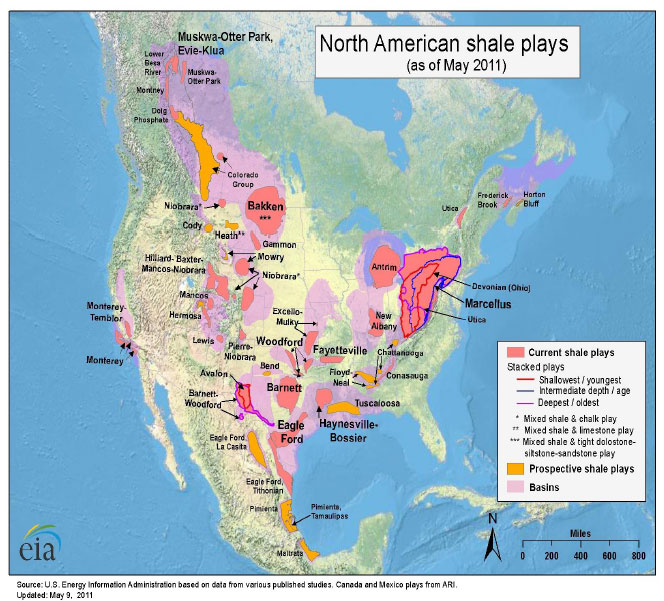
The Bakken formation is comprised of another potentially productive source rock which is the thin layer of dolomite rock formation known as the Three Forks formation. Because the Three Forks’ has a very high porosity and permeability, large percentages of its oil are recoverable. The Bakken formation is reportedly a prime producing formation with the potential of hosting tremendous amounts of oil and gas resources in excess of several billion barrels.
According to the U.S. Geological Survey (USGS), there may be as many as 503 billion barrels of oil in the entire Bakken Formation and more than 50 per cent of it is recoverable by currently available oil and gas producing technology. We plan to be actively involved in the exploration and production activities in these areas.
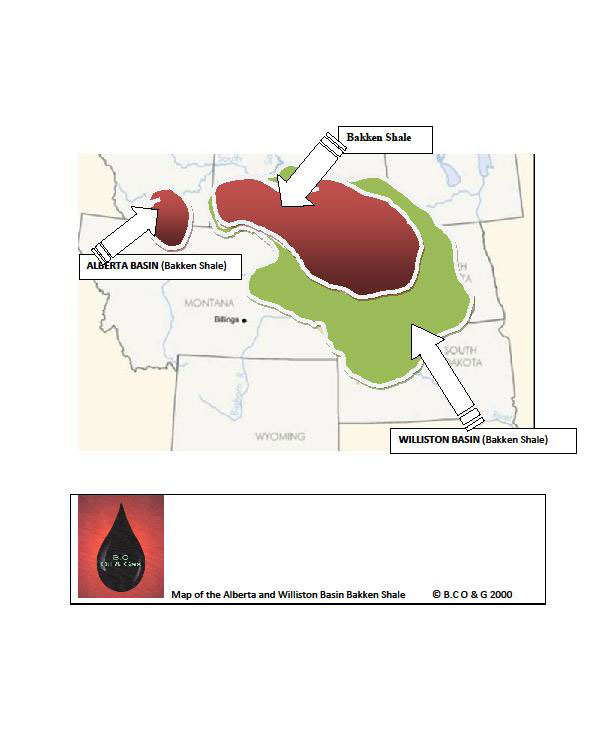
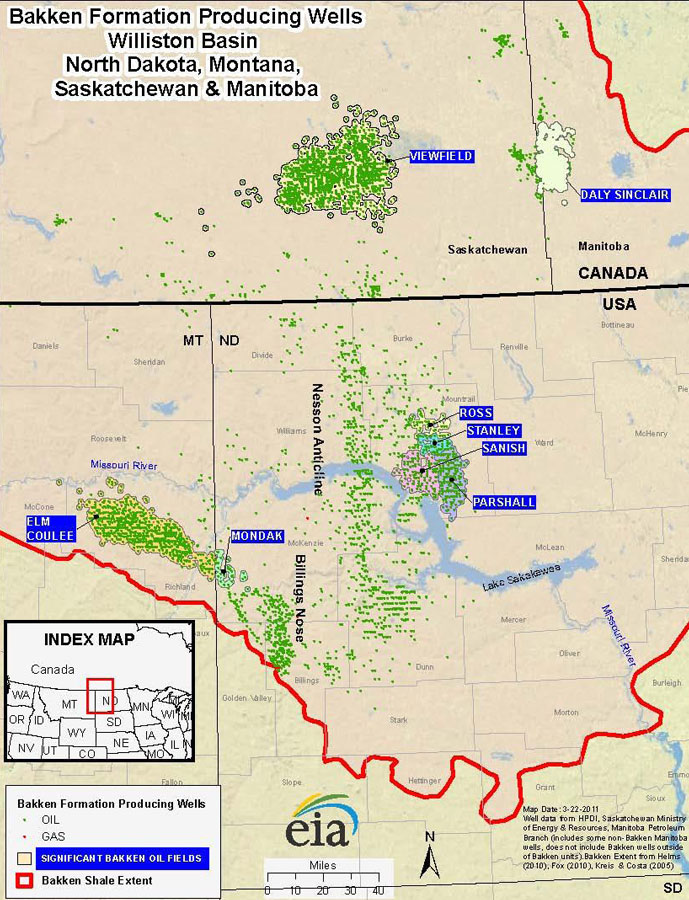
Souce: U.S Energy Information Administration
There are several production basins in the United States. Some of the oil and gas producing shale basins are shown in the map below.
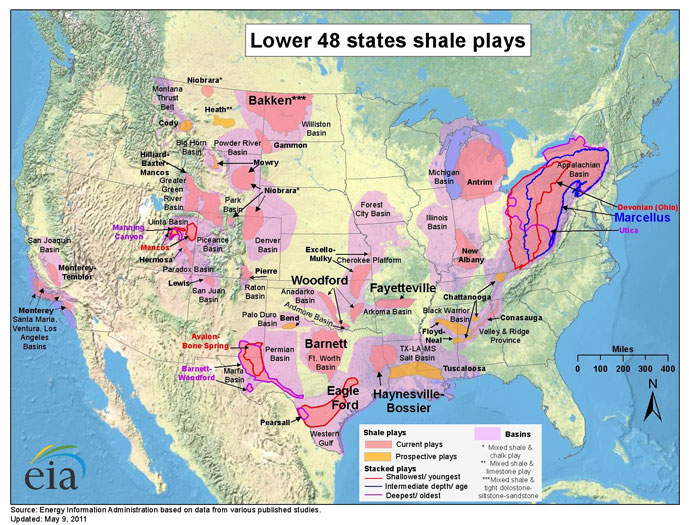
Souce: U.S Energy Information Administration
The Eagle Ford shale is one of the most challenging shale formations to develop for natural gas because of its deep high-pressure wells that are normally comingled for production of multiple but different formation zones for oil, condensate and natural gas liquids. Eagle Ford shale can be found as a strip band of bean-shaped shale rock formation right below the city of San Antonio extending approximately 500miles long to 75 miles wide.
Our exploration and production operations will also extend from Canadian Athabasca Oil sands and cover the rough expansive hardy terrain of the Bakken oil shale rock formation in Saskatchewan to Montana; to the Green River oil shale formation of Wyoming, Utah, and Colorado and North Dakota; including the Marcellus oil shale that stretches from West Virginia to New York; and the Barnett oil and gas shale in Texas, which includes the Wilcox sand oil formation in the Oklahoma Panhandle. The Barnett shale is a highly productive formation throughout the state of Texas
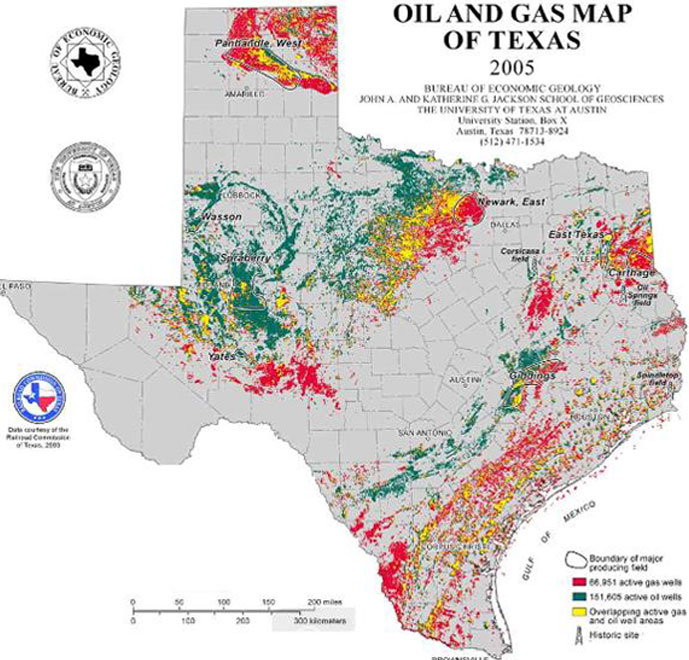
Producing Fields and Oil and Gas Wells in Texas
Source: University of Texas in Austin: Bureau of Economic Geology
The Green River Basin Oil Shale
Other areas of possible exploration include but may not be limited to the Green River oil shale. This is a productive Eocene sedimentary geologic rock formation located in Wyoming, Utah, and Colorado extending to the western edge of the Rocky Mountain ranges. The Utah portion of the productive field can be found in the Uinta Basin between the cities of Price and Vernal.
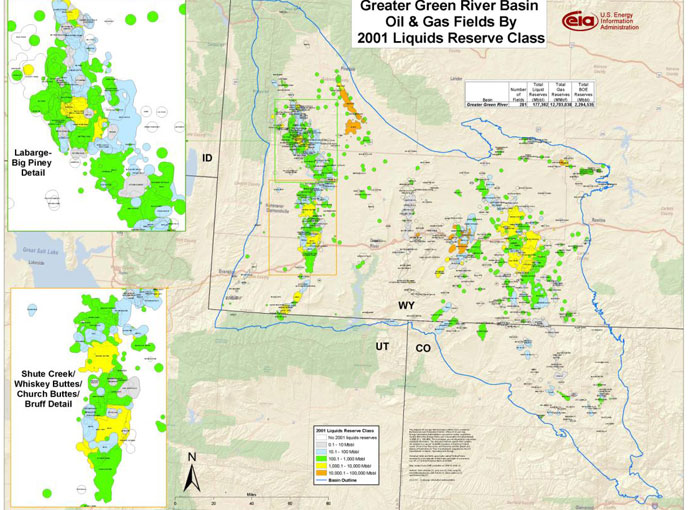
Souce: U.S Energy Information Administration
The Colorado portion which purportedly holds the greatest amount of the oil shale formation is present in the Piceance Creek Basin between Grand Junction and Rifle cities, located north and south of the Colorado River respectively. Primarily this oil shale rock formation is found in the expansive area of northwestern Colorado east of Uintas and in the southwestern corner of Wyoming north of Uintas and North-eastern Utah and Western Colorado south of the Uintas and along the present Green River, which is a tributary of the Colorado River. It is estimated that the Green River basin oil shale is holding between1.5 to 2.5 Trillion barrels of oil, and approximately 900 million to 1.5 billion barrels of oil are recoverable from the shale formation.
Canadian Oil Sands
Other potential future prospects include the Canadian oil sands. Oil sands are viscous liquid hydrocarbon impregnated petroleum sands that require further processing following extractions from above or below the ground. Oil sands deposits are abundant in many countries all over the world –especially in the United States, Russia and a variety of countries in Africa (Nigeria, Ghana) and the Middle East. However, the largest Oil sands deposits are found in Venezuela and Canada.
Canada also has the third largest oil reserves in the world, surpassed only by Saudi Arabia and Venezuela, but 97 percent of it is in the oil sands. Extracting the oil from sands in an ecologically friendly manner with minimum carbon footprint is currently a serious and contentious issue in Canada. According to Alberta Energy Resources Conservation Board (ERCB) and the Canadian Oil and Gas Journal, Canada has an estimated 175 billion barrels of oil that can be recovered economically with today’s technology, and approximately 170 billion barrels of it are located in the oil sands.
Oil sands are geologic sandy-clay rock formations consisting of a natural mixture of sand, water, clay and thick “heavy” oil called bitumen. In most cases the oil appeared as thick viscous, saturated heavy oil that is difficult to pump without having been heated first.
Canadian Oil sands are geographically restricted regionally and are primarily found in three major deposits of the Athabasca, Peace River and Cold Lake deposits of Alberta and Saskatchewan provinces as shown below.
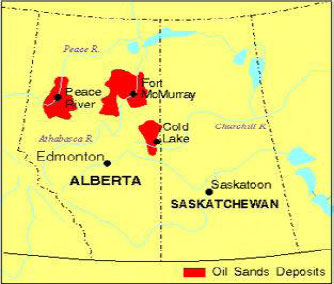
Canadian Oil sands General location Map
Source: Canadian Encyclopedia: Oil Sands Map
While the oil sands are found in some areas in deep underground beds of more than 200 feet, they generally appear as shallow deposits near the surface especially in the area of Fort McMurray. Many companies have successfully mined and extracted the bitumen oil sands in Alberta for a long time. There are two different methods available for producers to recover oil from bitumen sands and they are by direct surface mining and/or drilling (in situ). Any selected method is dependent upon how deep the oil sands reserves are.
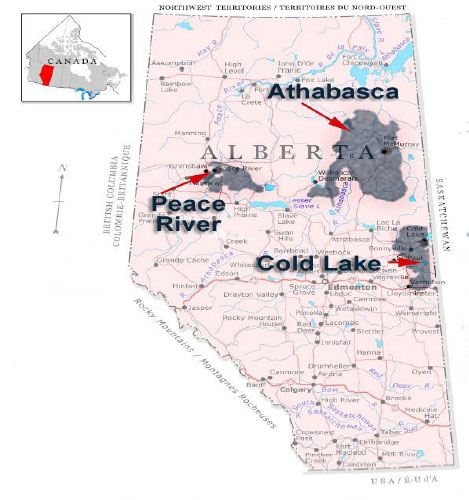
Canadian Oil sands Specific Extent Map
Source: Hope Care Foundation
Oil sands production in Canada provides a new additional source of energy fuel for the petroleum industry. It is a reliable, secured and easily accessible source of low-cost extractable hydrocarbons. Canada’s oil sands extraction and production will reduce our energy dependence and reliance on foreign crude oil imports while creating jobs and economic developments in both Canada and the United States. However, some of the key environmental issues facing prospectors and oil sands mining operators are the problem of disposal of fluid tailings from oil sands mining, and how to make the mined site safe and ready for reclamation.
Other Potential Opportunities
Most of the world's largest oil and gas corporations are paying attention to Africa and spending billions of dollars on exploration. We plan to be part of these efforts to build Africa and its natural, crude and petroleum resources.
Our plan to enter Africa, (--especially the West African oil and natural gas exploration and production market) was partially informed by a recent assessment from the U.S Geological Survey and the past report issued by the USGS--World Assessment 2000, on the four geologic provinces located along the northwest and West-Central African coast extending offshore to a water depth of 4,000 meters.
These provinces are (1) the Senegal Province, containing the passive-marginal Senegal Basin of Middle Jurassic to Holocene age; (2) the Gulf of Guinea Province, characterized by transform tectonics; (3) the Niger Delta Province, containing more than 9,100m of sediments; and (4) the West-Central Coastal Province, containing the Aptian salt basin, dominated by both rift and sag tectonics including the Congo Basin.
Using a geology-based assessment methodology, the USGS estimated mean volumes of 71.7 billion barrels of oil, 187.2 trillion cubic feet of natural gas, and 10.9 billion barrels of natural gas liquids from these provinces.
According to the USGS report (The assessment was based on geology and the use of the total petroleum system (TPS) concept. The geologic elements of a TPS include hydrocarbon source rocks (source rock maturation and hydrocarbon generation and migration, reservoir rocks (quality and distribution), and traps for hydrocarbon accumulation. Using these geologic criteria, seven conventional total petroleum systems and nine assessment units (AU) in the four provinces were defined, and the undiscovered, technically recoverable oil and gas resources were assessed.
More than 275 new fields have been discovered in the four western Africa provinces since the 2000 assessment and the assessment of undiscovered, technically recoverable conventional oil and gas resources in these West African provinces are phenomena.)
In the southern part of Nigeria, we have working interests involving exploration, discovery and production of oil and gas; with reported estimated reserves of large amounts of undeveloped oil and gas fields.
Current effort is underway to explore, and with serious intention, produce from the oil sands in the Southwestern part of Nigeria. The oil sands and the hydrocarbons within will be processed and the crude extracted either through surface mining and/or cold flow drilling methods, depending upon the most effective and energy efficient techniques.
Other active areas in Nigeria will be examined for potential oil and gas exploration opportunities. Nigeria is the eighth largest exporter of crude oil in the world. According to the Oil and Gas Journal, Nigeria had an estimated 37.2 billion barrels of proven oil reserves as of January 2011. These reserves are located in different formations offshore and onshore. The country has a current daily production capacity of nearly 2.5 million barrels a day and untold amounts of natural gas. The majority of the reserves are found along the country's Niger River Delta and offshore in the Bight of Benin, the Gulf of Guinea, and the Bight of Bonny. Current exploration activities are mostly focused in the deep and ultra-deep offshore reserves with some activities in the Lake Chad basin, located in the northeast of the country.
There are several producing and potentially productive basins in Nigeria. These basins include the Lake Chad Basin, Sokoto, Benue Trough, and the Anambra Basin. Key potential crude oil producing sedimentary basins include but are not limited to the Sokoto, Bida, Gongola/Yola, and Dahomey basins. The Lake Chad basin is one of the largest basins in Africa and it is located in Northern Central Africa covering approximately 8-10% of the continent of Africa and spreading over several countries including Nigeria. Recently, the Federal government of Nigeria, in cooperation with Chinese Oil explorers is intensifying efforts to explore crude oil in the Sokoto and Chad Basins.
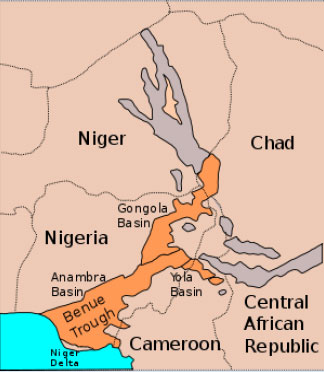
Source: Wikipedia.org
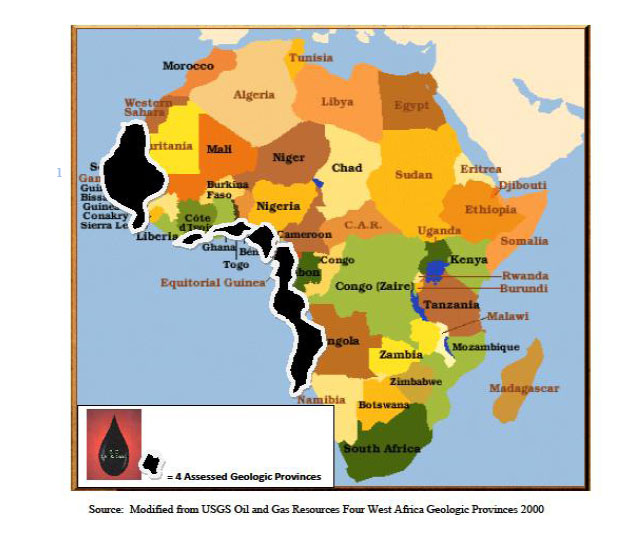
The United States Geological Survey, in collaboration with the U.S. Department of the Interior, conducted a detailed geological study of the entire continent of Africa and produced the map below showing current and potential oil and gas fields and geologic provinces of Africa.
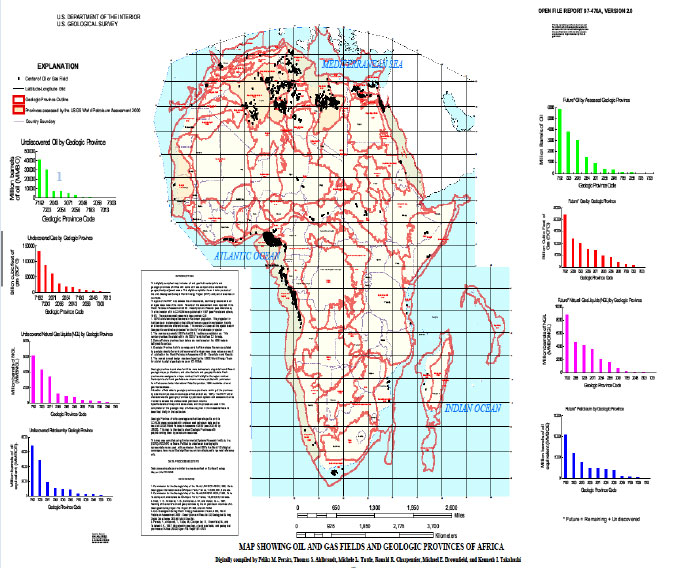
Map showing oil and gas fields and geologic provinces of Africa
Source: Courtesy of the USGS
With recent changes in the government of Libya, the country looks very promising and more attractive for oil and gas ventures because of its low cost oil recovery (as low as $1 per barrel at some fields), the high quality of its oil, its proximity to European markets and its well-developed oil and gas infrastructures.
With adequate cash flow and increases in net income and production over the next several years, Black Crystal Oil and Gas plans to invest $500million for drilling exploratory wells and $1.50 billion for proven reserve acquisitions in various fields. The economic vitality of our organization is dependent upon these investments. With such an investment, and in pursuit of excellence, we can establish a global presence and the economic strength, essential to the growth of our organization as one of the premier independent oil and gas exploration and production companies in the world.
Summary List of Current and Potential Future Areas of Our Operations include but are not limited to:-
- U.S.A
- Canada
- China
- Algeria
- Cameroon
- Egypt
- United Kingdom
- Nigeria
- Equatorial Guinea
- Benin Republic
- Zambia
- Namibia
- Angola
- Iraq
- Libya
- Brazil
- French Guyana
- Venezuela
- Australia
- Mauritania
- Oman
- Indonesia
- Ghana
THE FORMULA FOR OUR SUCCESS
Black Crystal Oil & Gas + Crude  & Natural Gas = Energy & Profit.
& Natural Gas = Energy & Profit.
Black Crystal Oil  Gas
Gas
“Excellence is a habit and it is the soul of our business”
P. O. Box 794734 Dallas, TX 75379-4734. USA. Email: mail@blackcrystaloilandgas.com